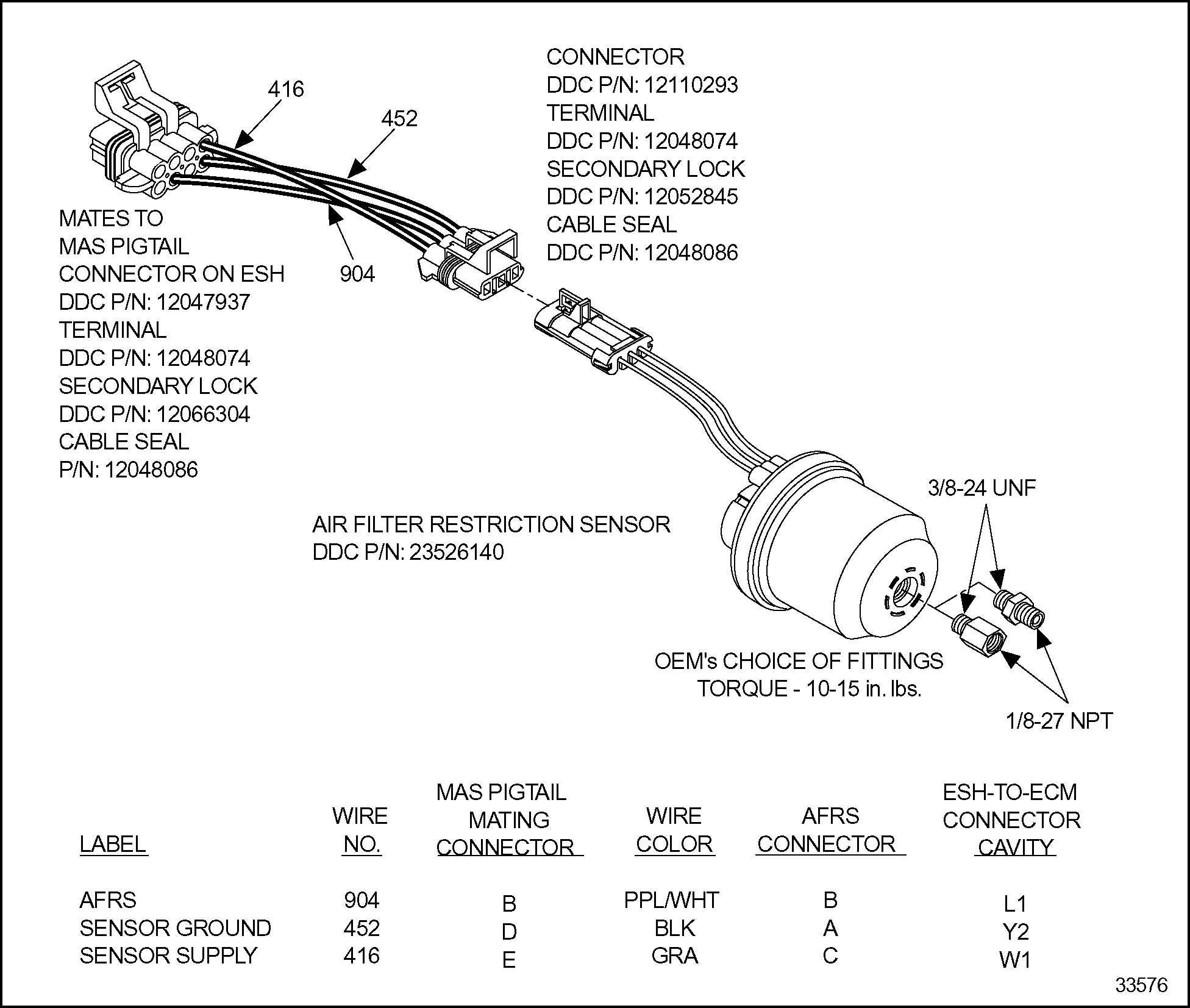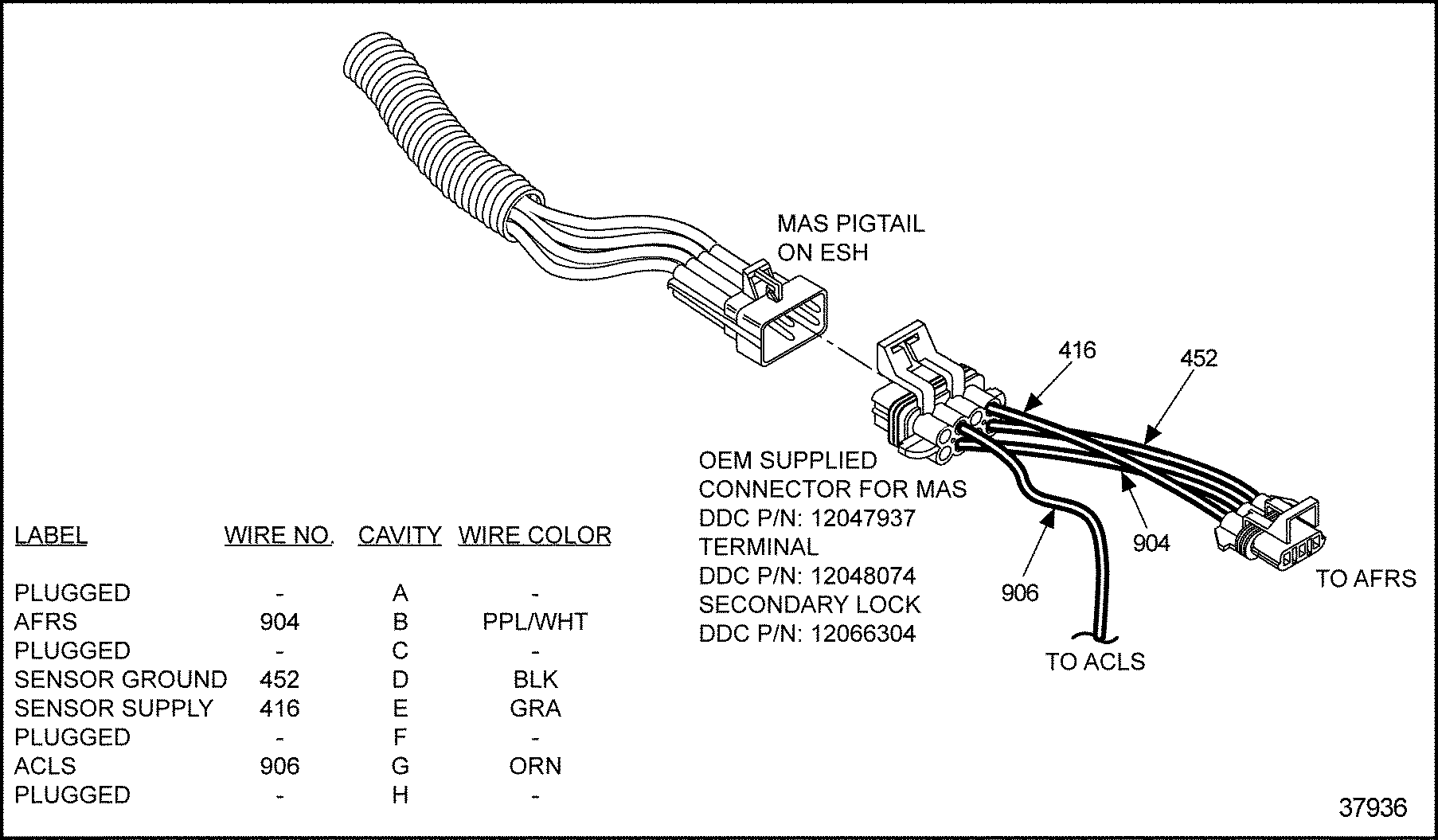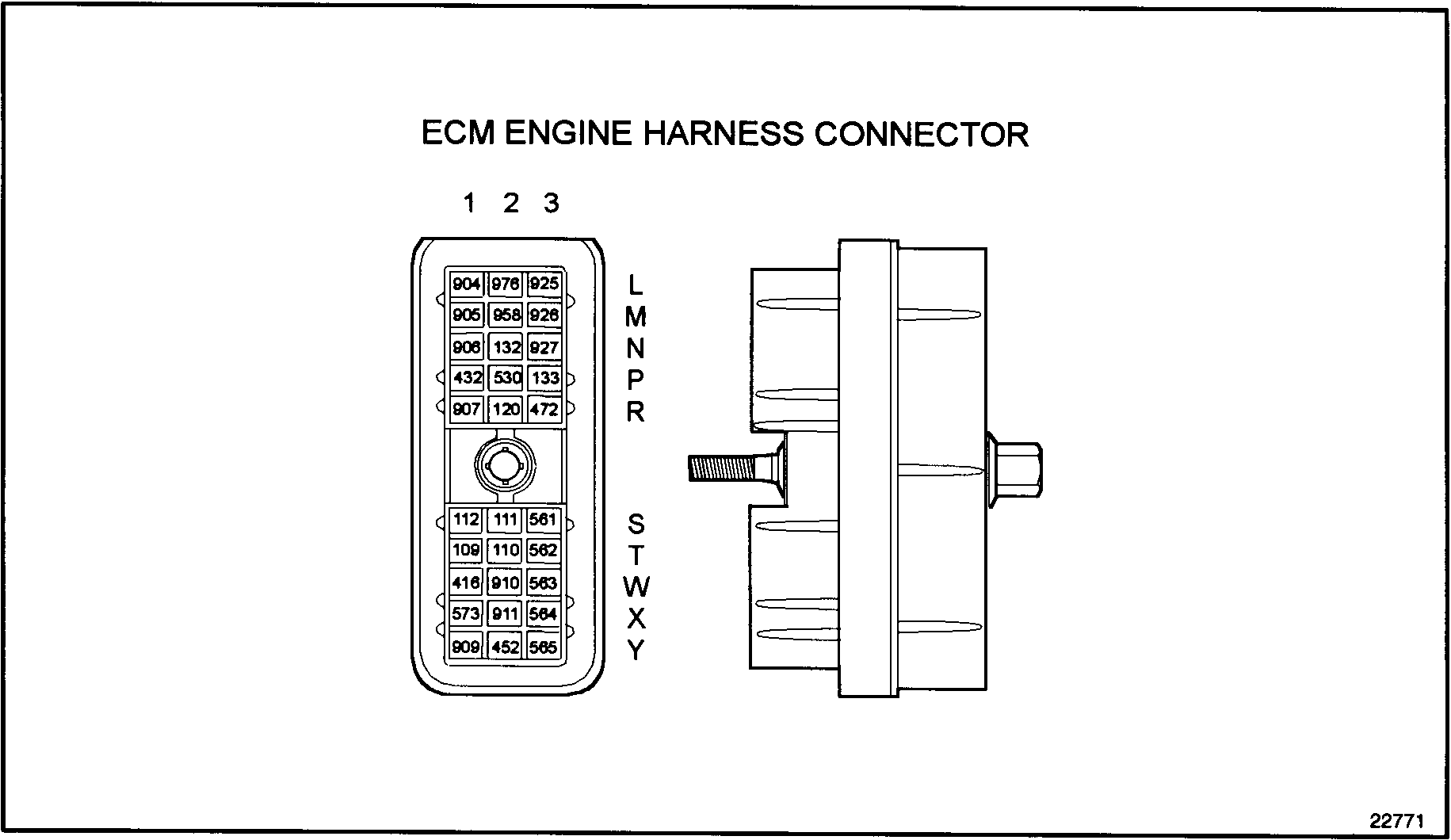Section 65.4
Air Filter Restriction Sensor
Follow these procedures to troubleshoot code 65, 107/3, AFRS (Air Filter Restriction Sensor) failed high; and 107/4, AFRS failed low:
Section 65.4.1
Multiple Code Check
Perform the following steps to check for multiple codes.
- Turn vehicle ignition switch ON.
- Plug the diagnostic data reader (DDR) into the diagnostic data link (DDL).
- Read active codes.
- If code 107/3 and no other codes were logged, refer to "65.4.2 Sensor Check" .
- If code 107/4 or any other codes were logged, refer to "65.4.9 Multiple Code Check" .
Section 65.4.2
Sensor Check
Perform the following steps to check the sensor.
- Turn ignition switch OFF.
- Disconnect AFRS (Air Filter Restriction Sensor) connector. See Figure
"Air Filter Restriction Sensor Wiring Diagram"
. See Figure
"MAS Pigtail"
.

Figure 1. Air Filter Restriction Sensor Wiring Diagram

Figure 2. MAS Pigtail
- Turn ignition ON.
- Start and run the engine.
- Select engine temperature (COOLANT TEMP or OIL TEMP) on the DDR.
- Warm up engine until engine temperature reading is greater than 60°C (140°F).
- After warm-up, let engine run at idle.
- Read active codes.
- If active code 107/3 and any other codes were logged, refer to "65.4.5 Check for Signal Short to 5 Volt" .
- If code 107/4 and any other codes except 107/3 were logged, refer to "65.4.3 Return Circuit Check" .
Section 65.4.3
Return Circuit Check
Perform the following steps to check the return circuit.
- Turn vehicle ignition OFF.
- Disconnect the engine harness connector at the ECM.
- Install a jumper wire between pin A and pin B of the AFRS harness connector. See Figure "Engine Harness Connector to Air Filter Restriction Sensor" .
- Measure resistance between sockets L1 and Y2 on the engine harness connector.
- If resistance measurement is less than or equal to 5 Ω, refer to "65.4.4 Check Air Filter Sensor Connectors" .
- If resistance measurement is greater than 5 Ω, the return line (#452) is open. Repair the open and refer to "65.4.8 Verify Repairs" .

Figure 3. Engine Harness Connector to Air Filter Restriction Sensor
Section 65.4.4
Check Air Filter Sensor Connectors
Perform the following steps to check the AFRS connectors.
- Check terminals at the AFRS connectors (both the sensor and harness side) for damage: bent, corroded and unseated pins or sockets.
- If the terminals and connectors are damaged, repair them and refer to "65.4.8 Verify Repairs" .
- If the terminals and connectors are not damaged, replace the AFRS. Refer to "65.4.8 Verify Repairs" .
Section 65.4.5
Check for Signal Short to 5 Volt
Perform the following steps to check for signal open.
- Turn vehicle ignition OFF.
- Disconnect the engine harness connector at the ECM.
- Measure resistance between sockets L1 and W1 on the engine harness connector. See Figure
"ECM Engine Harness Connector"
.
- If the resistance measurement is less than or equal to 100 Ω, the signal line (#904) is shorted to the engine +5 volt line (#416). Repair the short and refer to "65.4.8 Verify Repairs" .
- If the resistance measurement is greater than 100 Ω, or open, refer to "65.4.6 Check for Short to Battery (+)" .

Figure 4. ECM Engine Harness Connector
Section 65.4.6
Check for Short to Battery (+)
Perform the following steps to check for a short to battery (+).
- Remove both fuses to the ECM.
- Disconnect the vehicle harness and 5-way power connectors at the ECM. See Figure "ECM Vehicle Harness Connector" .
- Measure resistance between socket L1 on the engine harness connector and socket B3 of the vehicle harness connector, and between L1 and the 5-way power harness sockets A and C. See Figure
"ECM Engine Harness Connector"
. See Figure
"ECM Vehicle Harness Connector"
.
- If resistance measurement is greater than 100 Ω, or open, refer to "65.4.7 Check ECM Connector" .
- If resistance measurement is less than or equal to 100 Ω, a short exists between sockets where less than 100 Ω resistance was read. Repair short and reinsert fuses. Refer to "65.4.8 Verify Repairs" .

Figure 5. ECM Vehicle Harness Connector
Section 65.4.7
Check ECM Connector
Perform the following steps to check the ECM connector:
- Inspect the terminals at the ECM connector (ECM and harness side) for damage: bent, corroded, and unseated pins or sockets.
- If the terminals and connector are damaged, repair both and refer to "65.4.8 Verify Repairs" .
- If the terminals and connector are not damaged, refer to "65.4.4 Check Air Filter Sensor Connectors" .
Section 65.4.8
Verify Repairs
Perform the following steps to verify repairs:
- Turn ignition switch OFF.
- Reconnect all connectors.
- Turn ignition ON.
- Clear codes.
- Start and run the engine for one minute.
- Stop engine.
- Check codes with DDR.
- If no codes are logged, no further troubleshooting is required.
- If code 107/3 is not logged, but other codes are logged, refer to "9.1 First Step for Diagnosing a Fault Within the DDEC System" .
- If code 107/3 is logged, all system diagnostics are complete. Contact Detroit Diesel Technical Service.
Section 65.4.9
Multiple Code Check
Perform the following steps to check for multiple codes.
- Plug the diagnostic data reader (DDR) into the diagnostic data link (DDL).
- Turn vehicle ignition switch ON.
- Read active codes.
- If code 107/4 and no other codes were logged, refer to "65.4.10 Sensor Check" .
- If code 107/4 was logged and none of the following codes were logged: 110/3 or 4, 174/3 or 4, 175/3 or 4, 101/3 or 4, 102/3 or 4, 73/3 or 4, 94/3 or 4, 100/3, refer to "65.4.10 Sensor Check" .
- If code 107/4 and any of the following codes were logged: 110/3 or 4, 174/3 or 4, 175/3 or 4, 101/3 or 4, 102/3 or 4, 73/3 or 4, 94/3 or 4, 100/3, refer to "90.1 Description of Engine Sensor Harness" .
Section 65.4.10
Sensor Check
Perform the following steps to check the sensor.
- Turn ignition switch OFF.
- Disconnect AFRS connector and install a jumper wire between sockets B and C of the AFRS harness connector. See Figure "Engine Harness Connector to Air Filter Restriction Sensor" .
- Turn ignition ON.
- Read active codes.
- If active codes 107/3 or 4 were logged, proceed with the following:
- If active code 107/4 and any other codes were logged, refer to "65.4.12 Check for +5 Volts" .
- If code 107/3 and any other codes except 107/4 were logged, refer to "65.4.11 Check Air Filter Sensor Connectors" .
- If active codes 107/3 or 4 were not logged, warm up engine until either codes are logged or the engine temperature (COOLANT TEMP or OIL TEMP or DDR) has been greater than 60°C (140°F) for one minute.
- If active code 107/4 and any other codes were logged, refer to "65.4.12 Check for +5 Volts" .
- If code 107/3 and any other codes except 107/4 were logged, refer to "65.4.11 Check Air Filter Sensor Connectors" .

Figure 6. Engine Harness Connector to Air Filter Restriction Sensor
Section 65.4.11
Check Air Filter Sensor Connectors
Perform the following steps to check the AFRS connectors.
- Turn ignition OFF.
- Check terminals at the AFRS connectors (both the sensor and harness side) for damage: bent, corroded and unseated pins or sockets.
- If the terminals and connectors are damaged, repair them and refer to "65.4.20 Verify Repairs" .
- If the terminals and connectors are not damaged, replace the AFRS. Refer to "65.4.20 Verify Repairs" .
Section 65.4.12
Check for +5 Volts
Perform the following steps to check for +5 volts.
- Turn vehicle ignition OFF.
- Remove jumper wire.
- Turn ignition ON.
- Measure voltage on AFRS harness connector, socket C (red test lead) to socket A (black test lead).
- If the voltage measurement is less than 4 volts, refer to "65.4.16 Check for Open +5 Volt Line" .
- If the voltage measurement is greater than 6 volts, refer to "65.4.18 Check for Short to Battery +" .
- If the voltage measurement is between 4 and 6 volts, refer to "65.4.13 Check for Signal Open" .
Section 65.4.13
Check for Signal Open
Perform the following steps to check for signal open.
- Turn the ignition OFF.
- Disconnect the engine harness connector at the ECM. See Figure "Engine Harness Connector to Air Filter Restriction Sensor" .
- Install a jumper wire between sockets A and B of the AFRS harness connector.
- Measure resistance between sockets L1 and Y2 on the engine harness connectors.
- If the resistance measurement is less than or equal to 5 Ω, refer to "65.4.19 Check for Short to Ground" .
- If the resistance measurement is greater than 5 Ω or open, the signal line (#904) is open. Repair the open and refer to "65.4.20 Verify Repairs" .

Figure 7. Engine Harness Connector to Air Filter Restriction Sensor
Section 65.4.14
Check for Short
Perform the following steps to check for a short.
- Remove jumper wire.
- Measure resistance between socket L1 and a good ground. Also measure resistance between L1 and Y2.
- If both resistance measurements are greater than 100 Ω or open, replace AFRS. Refer to "65.4.20 Verify Repairs" .
- If either resistance measurement is less than 100 Ω, the signal line (#904) is shorted to the return line (#452) or battery ground. Repair short and refer to "65.4.20 Verify Repairs" .
Section 65.4.15
Check ECM Connectors
Perform the following steps to check ECM connectors.
- Check terminals at the ECM harness connector (both ECM and harness side) for damage: bent, corroded and unseated pins or sockets. Check W1, L1 and Y2 terminals and pins at ECM.
- If the terminals and connectors are damaged, repair them and refer to "65.4.20 Verify Repairs" .
- If the terminals and connectors are not damaged, reprogram the ECM. Refer to "65.4.20 Verify Repairs" .
Section 65.4.16
Check for Open +5 Volt Line
Perform the following steps to check for open +5 volt line.
- Turn ignition OFF.
- Disconnect the engine harness connectors at the ECM.
- Install a jumper wire between pins A and C of the AFRS connector.
- Measure resistance between sockets W1 and Y2 on the engine harness connector.
- If the resistance measurement is less than or equal to 5 Ω, refer to "65.4.17 Check for Short" .
- If the resistance measurement is greater than 5 Ω or open, the engine +5 volt line (#416) is open. Repair the open and refer to "65.4.20 Verify Repairs" .
Section 65.4.17
Check for Short
Perform the following steps to check for a short.
- Remove jumper wire.
- Measure resistance between sockets A and C on the AFRS harness connector. Also measure resistance between socket C and a good ground.
- If either resistance measurement is less than or equal to 100 Ω, the engine +5 volt line (#416) is shorted to the return line (#452) or battery ground. Repair the short and refer to "65.4.20 Verify Repairs" .
- If the resistance measurement is greater than 100 Ω or open, replace AFRS and refer to "65.4.20 Verify Repairs" .
Section 65.4.18
Check for Short to Battery +
Perform the following steps to check for a short to battery.
- Remove both fuses to the ECM.
- Disconnect the vehicle harness and 5-way power connectors at the ECM. See Figure "ECM Vehicle Harness Connector" .
- Measure resistance between socket W1 on the engine harness connector and socket B3 of the vehicle harness connector, and between W1 and the 5-way power harness sockets A and C.
- If resistance measurement is greater than 100 Ω, or open, replace AFRS. Refer to "65.4.20 Verify Repairs" .
- If resistance measurement is less than or equal to 100 Ω, a short exists between sockets where less than 100 Ω resistance was read. Repair short and reinsert fuses. Refer to "65.4.20 Verify Repairs" .

Figure 8. ECM Vehicle Harness Connector
Section 65.4.19
Check for Short to Ground
Perform the following steps to check for a short to ground.
- Turn vehicle ignition OFF.
- Remove jumper wire.
- Measure resistance between sockets L1 and Y2 on the engine harness connector. See Figure
"Engine Harness Connector to Air Filter Restriction Sensor"
.
- If resistance measurement is greater than 100 Ω, or open, refer to "65.4.14 Check for Short" .
- If resistance measurement is less than or equal to 100 Ω, the signal line (#904) and return line (#452) are shorted together. Repair the short. Refer to "65.4.20 Verify Repairs" .

Figure 9. Engine Harness Connector to Air Filter Restriction Sensor
Section 65.4.20
Verify Repairs
Perform the following steps to verify repairs.
- Turn ignition switch OFF.
- Reconnect all connectors.
- Turn ignition ON.
- Clear codes.
- Start and run the engine for one minute.
- Stop engine.
- Check DDR for codes.
- If no codes are logged, troubleshooting is complete.
- If code 107/4 is not logged, and other codes are logged, refer to "9.1 First Step for Diagnosing a Fault Within the DDEC System" .
- If code 107/4 is logged, and other codes are logged, all system diagnostics are complete. Please review this section from the first step to find the error. Refer to "65.4.9 Multiple Code Check" . If no error is located, refer to "65.4.15 Check ECM Connectors" .
| DDEC III/IV Single ECM Troubleshooting Guide - 6SE497 |
| Generated on 10-13-2008 |